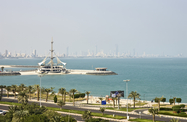With earnings from oil accounting for more than 80% of government income, the halving of prices since June has eroded state revenue and could impact the extensive capital works programme in 2015, despite a government pledge to hike this year’s spending by 4.5% from its earlier plans.
Oman’s economy is expected to expand by 5% in 2015, against an estimated 4.4% growth in GDP last year, according to a Ministry of Finance statement in early January. Growth in non-oil activities is expected to reach 5.5% while government expenditure is estimated at OR14.1bn ($36.6bn). Revenues are projected at OR11.6bn ($30.1bn), which leaves an anticipated deficit of OR2.5bn ($6.5bn), equivalent to about 8% of Oman's annual GDP.
The ministry said it would look at a range of ways to cover the shortfall including grants from foreign donors, international loans, borrowing from the local market, state reserve funds and previous years' surpluses according to local media reports.
Oil down, pressure up
Ratings agency Moody’s warned in December that Oman will come under pressure in 2015 because of the high energy prices needed to balance its budget and its more modest reserve buffers. In January oil prices had dipped below the $50 per barrel mark, well below Oman’s estimated $107 break-even point. Moody’s said that Oman is likely to bridge any fiscal gap through sovereign debt issuance in 2015.
Ratings agency Standard and Poor’s (S&P) also flagged concerns over the impact of oil prices on Oman’s economy, lowering its outlook for the sovereign rating from stable to negative in an investor note issued in early December. It said that the deterioration in its fiscal or external positions could be sharper than expected because of the oil price slide.
Predicting a modest surplus in 2014, the agency forecasts that the budget will move into deficit and remain there until at least 2017.
Oman has already sought to find alternatives for oil and gas revenues by investing heavily in agricultural, industrial, fisheries, tourism and other sectors. Indeed, the non-oil component of the economy recorded a solid growth rate in the first half of 7.3% against a modest contraction of the hydrocarbons sector of 0.4%, according to data issued by the Central Bank of Oman in mid-December.
S&P added that investment in transport infrastructure, petrochemicals and development of the Khazzan tight gas field will help drive economic activity in the next few years.
Cutting costs
The government has already moved to bridge any budgetary gap, proposing a series of revenue raising measures. In late November, a plan was mooted to increase royalty fees levied on telecommunications and mining companies, with the Oman Advisory Council, an advisory board to Oman’s government, suggesting lifting levies on revenue from 7% to 12%. Another proposal is for a 2% levy on remittances transferred by foreign workers, along with cuts in state spending in development, defence and energy.
One measure that has been approved is for the doubling of the price of natural gas to companies, with the increase from the present rate of $1.50 per million British thermal units to $3 set to come into force as of January 1. Announced in late November, the decision includes a provision for annual increases of 3% in subsequent years.
The new tariff is expected to push up production costs for industry, despite the new tariff still being discounted on international market rates. This has prompted warnings from some manufacturers that the higher prices will cut into growth and could result in business closures and job losses. In particular, companies operating in the construction materials segment, producing cement, glass and metals used in the building trade, will see costs rise in 2015. The new tariff will add to the price tags of both public and private infrastructure and construction projects.
The Muscat Securities Market (MSM) has felt the impact of the falling fortunes of the hydrocarbons sector, with the exchange’s index shedding 25% from the close of the third quarter to December. With uncertainty remaining over when oil prices will find their base in 2015, the MSM may see a further volatility in 2015.

